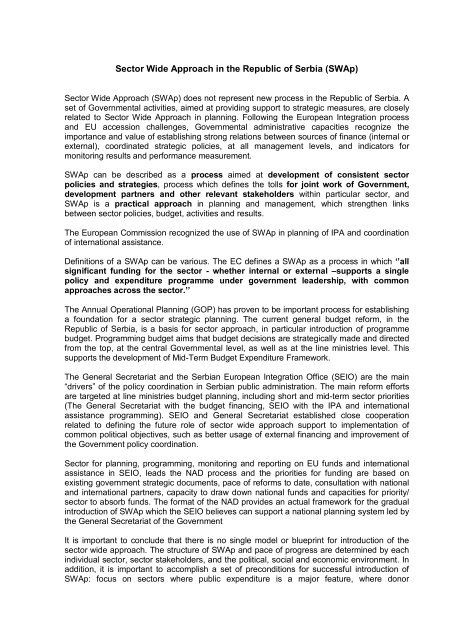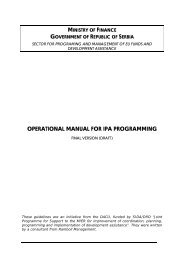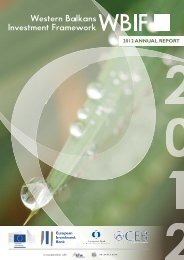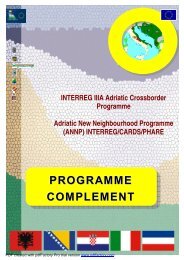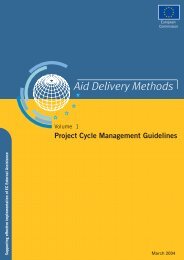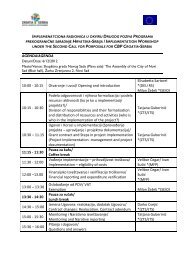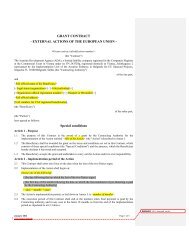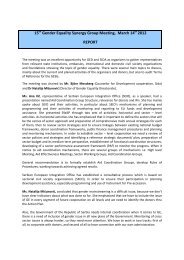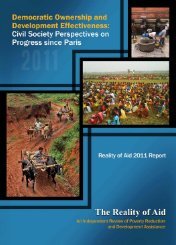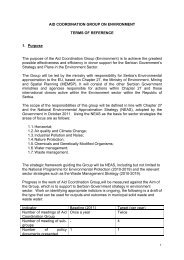Sector Wide Approach in the Republic of Serbia (SWAp)
Sector Wide Approach in the Republic of Serbia (SWAp)
Sector Wide Approach in the Republic of Serbia (SWAp)
You also want an ePaper? Increase the reach of your titles
YUMPU automatically turns print PDFs into web optimized ePapers that Google loves.
<strong>Sector</strong> <strong>Wide</strong> <strong>Approach</strong> <strong>in</strong> <strong>the</strong> <strong>Republic</strong> <strong>of</strong> <strong>Serbia</strong> (<strong>SWAp</strong>)<br />
<strong>Sector</strong> <strong>Wide</strong> <strong>Approach</strong> (<strong>SWAp</strong>) does not represent new process <strong>in</strong> <strong>the</strong> <strong>Republic</strong> <strong>of</strong> <strong>Serbia</strong>. A<br />
set <strong>of</strong> Governmental activities, aimed at provid<strong>in</strong>g support to strategic measures, are closely<br />
related to <strong>Sector</strong> <strong>Wide</strong> <strong>Approach</strong> <strong>in</strong> plann<strong>in</strong>g. Follow<strong>in</strong>g <strong>the</strong> European Integration process<br />
and EU accession challenges, Governmental adm<strong>in</strong>istrative capacities recognize <strong>the</strong><br />
importance and value <strong>of</strong> establish<strong>in</strong>g strong relations between sources <strong>of</strong> f<strong>in</strong>ance (<strong>in</strong>ternal or<br />
external), coord<strong>in</strong>ated strategic policies, at all management levels, and <strong>in</strong>dicators for<br />
monitor<strong>in</strong>g results and performance measurement.<br />
<strong>SWAp</strong> can be described as a process aimed at development <strong>of</strong> consistent sector<br />
policies and strategies, process which def<strong>in</strong>es <strong>the</strong> tolls for jo<strong>in</strong>t work <strong>of</strong> Government,<br />
development partners and o<strong>the</strong>r relevant stakeholders with<strong>in</strong> particular sector, and<br />
<strong>SWAp</strong> is a practical approach <strong>in</strong> plann<strong>in</strong>g and management, which streng<strong>the</strong>n l<strong>in</strong>ks<br />
between sector policies, budget, activities and results.<br />
The European Commission recognized <strong>the</strong> use <strong>of</strong> <strong>SWAp</strong> <strong>in</strong> plann<strong>in</strong>g <strong>of</strong> IPA and coord<strong>in</strong>ation<br />
<strong>of</strong> <strong>in</strong>ternational assistance.<br />
Def<strong>in</strong>itions <strong>of</strong> a <strong>SWAp</strong> can be various. The EC def<strong>in</strong>es a <strong>SWAp</strong> as a process <strong>in</strong> which ‘’all<br />
significant fund<strong>in</strong>g for <strong>the</strong> sector - whe<strong>the</strong>r <strong>in</strong>ternal or external –supports a s<strong>in</strong>gle<br />
policy and expenditure programme under government leadership, with common<br />
approaches across <strong>the</strong> sector.’’<br />
The Annual Operational Plann<strong>in</strong>g (GOP) has proven to be important process for establish<strong>in</strong>g<br />
a foundation for a sector strategic plann<strong>in</strong>g. The current general budget reform, <strong>in</strong> <strong>the</strong><br />
<strong>Republic</strong> <strong>of</strong> <strong>Serbia</strong>, is a basis for sector approach, <strong>in</strong> particular <strong>in</strong>troduction <strong>of</strong> programme<br />
budget. Programm<strong>in</strong>g budget aims that budget decisions are strategically made and directed<br />
from <strong>the</strong> top, at <strong>the</strong> central Governmental level, as well as at <strong>the</strong> l<strong>in</strong>e m<strong>in</strong>istries level. This<br />
supports <strong>the</strong> development <strong>of</strong> Mid-Term Budget Expenditure Framework.<br />
The General Secretariat and <strong>the</strong> <strong>Serbia</strong>n European Integration Office (SEIO) are <strong>the</strong> ma<strong>in</strong><br />
“drivers” <strong>of</strong> <strong>the</strong> policy coord<strong>in</strong>ation <strong>in</strong> <strong>Serbia</strong>n public adm<strong>in</strong>istration. The ma<strong>in</strong> reform efforts<br />
are targeted at l<strong>in</strong>e m<strong>in</strong>istries budget plann<strong>in</strong>g, <strong>in</strong>clud<strong>in</strong>g short and mid-term sector priorities<br />
(The General Secretariat with <strong>the</strong> budget f<strong>in</strong>anc<strong>in</strong>g, SEIO with <strong>the</strong> IPA and <strong>in</strong>ternational<br />
assistance programm<strong>in</strong>g). SEIO and General Secretariat established close cooperation<br />
related to def<strong>in</strong><strong>in</strong>g <strong>the</strong> future role <strong>of</strong> sector wide approach support to implementation <strong>of</strong><br />
common political objectives, such as better usage <strong>of</strong> external f<strong>in</strong>anc<strong>in</strong>g and improvement <strong>of</strong><br />
<strong>the</strong> Government policy coord<strong>in</strong>ation.<br />
<strong>Sector</strong> for plann<strong>in</strong>g, programm<strong>in</strong>g, monitor<strong>in</strong>g and report<strong>in</strong>g on EU funds and <strong>in</strong>ternational<br />
assistance <strong>in</strong> SEIO, leads <strong>the</strong> NAD process and <strong>the</strong> priorities for fund<strong>in</strong>g are based on<br />
exist<strong>in</strong>g government strategic documents, pace <strong>of</strong> reforms to date, consultation with national<br />
and <strong>in</strong>ternational partners, capacity to draw down national funds and capacities for priority/<br />
sector to absorb funds. The format <strong>of</strong> <strong>the</strong> NAD provides an actual framework for <strong>the</strong> gradual<br />
<strong>in</strong>troduction <strong>of</strong> <strong>SWAp</strong> which <strong>the</strong> SEIO believes can support a national plann<strong>in</strong>g system led by<br />
<strong>the</strong> General Secretariat <strong>of</strong> <strong>the</strong> Government<br />
It is important to conclude that <strong>the</strong>re is no s<strong>in</strong>gle model or bluepr<strong>in</strong>t for <strong>in</strong>troduction <strong>of</strong> <strong>the</strong><br />
sector wide approach. The structure <strong>of</strong> <strong>SWAp</strong> and pace <strong>of</strong> progress are determ<strong>in</strong>ed by each<br />
<strong>in</strong>dividual sector, sector stakeholders, and <strong>the</strong> political, social and economic environment. In<br />
addition, it is important to accomplish a set <strong>of</strong> preconditions for successful <strong>in</strong>troduction <strong>of</strong><br />
<strong>SWAp</strong>: focus on sectors where public expenditure is a major feature, where donor
<strong>in</strong>volvement is large enough for coord<strong>in</strong>ation <strong>in</strong>tervention, an agreement between<br />
government and donors on strategic direction, a supportive national budget environment<br />
(M<strong>in</strong>istry <strong>of</strong> F<strong>in</strong>ance) to allow sector authorities to plan with a degree <strong>of</strong> budgetary confidence<br />
and where policy <strong>in</strong>centives are compatible with <strong>SWAp</strong> objectives.


